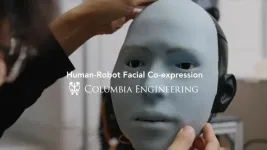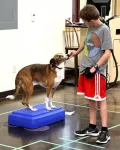(Press-News.org) MINNEAPOLIS/ST. PAUL (3/27/2024) — University of Minnesota Medical School researchers have introduced a new, refined method for analyzing brain signals, enhancing our understanding of brain functionality. This research has the potential to improve treatments for neurological conditions such as Parkinson's disease, pain, epilepsy and depression. The findings were recently published in NeuroImage.
"This breakthrough provides a more detailed understanding of the brain's complex activity, akin to upgrading from a basic telescope to a sophisticated space observatory,” said David Darrow, MD, MPH, an assistant professor at the U of M Medical School, a neurosurgeon with M Health Fairview and senior author. “This innovation could impact various aspects of everyday life — from education and mental health to artificial intelligence, paving the way for future technological advancements and a deeper understanding of human cognition.”
One of the key findings of this research is the enhanced ability to analyze direct brain recordings — meaning scientists can now better understand how brain activity correlates to different tasks and behaviors. Additionally, this method allows researchers to directly extract patterns of brain activity over time, revealing how different brain areas process stimuli during tasks such as image identification.
“This research represents a significant advance in our ability to analyze neural signals. It opens up new possibilities for understanding the complex dynamics of the human brain, paving the way for future discoveries in neuroscience,” said Alexander Herman, MD, PhD, an assistant professor of psychiatry at the University of Minnesota Medical School, attending psychiatrist with M Health Fairview and co-senior author.
The research team is working on the next iteration of the platform, which will allow them to decode brain signals and apply strategies for integrating them into medical devices and new treatments.
Funding was provided by the National Institute of Drug Addiction [5K23DA050909] and the Brain & Behavior Research Foundation. This research was also supported by the University of Minnesota's MnDRIVE (Minnesota's Discovery, Research and Innovation Economy) initiative.
###
About the University of Minnesota Medical School
The University of Minnesota Medical School is at the forefront of learning and discovery, transforming medical care and educating the next generation of physicians. Our graduates and faculty produce high-impact biomedical research and advance the practice of medicine. We acknowledge that the U of M Medical School is located on traditional, ancestral and contemporary lands of the Dakota and the Ojibwe, and scores of other Indigenous people, and we affirm our commitment to tribal communities and their sovereignty as we seek to improve and strengthen our relations with tribal nations. For more information about the U of M Medical School, please visit med.umn.edu.
END
University of Minnesota researchers introduce enhanced brain signal analysis technique
2024-03-27
ELSE PRESS RELEASES FROM THIS DATE:
Aston University research center to focus on using AI to improve lives
2024-03-27
• New centre specifically focuses on using AI to improve society
• Current research is designed to improve transport, health and industry
• “There have been a lot of reports focusing on the negative use of AI...this is why the centre is so important now.”
Aston University researchers have marked the opening of a new centre which focuses on harnessing artificial intelligence (AI) to improve people’s lives.
The Aston ...
Robot, can you say ‘cheese’?
2024-03-27
What would you do if you walked up to a robot with a human-like head and it smiled at you first? You’d likely smile back and perhaps feel the two of you were genuinely interacting. But how does a robot know how to do this? Or a better question, how does it know to get you to smile back?
While we’re getting accustomed to robots that are adept at verbal communication, thanks in part to advancements in large language models like ChatGPT, their nonverbal communication skills, especially facial expressions, have lagged far behind. Designing a robot that can not only make a wide range ...
Filters, coupled with Digital Health Program, reduced arsenic levels by nearly half in study participants in households relying on well water in American Indian Communities
2024-03-27
A community-led water-testing project made up of households that rely on private well water with high arsenic levels saw on average a 47 percent drop in participants’ urinary arsenic levels after filters were installed and a digital health program was implemented, according to a new study led by researchers at the Johns Hopkins Bloomberg School of Public Health. Over the two-year study period, participating households received phone calls to encourage use of the filter and a reminder to replace the filter cartridge.
For the study—a ...
Oregon State dog-training program helps increase physical activity among kids with disabilities
2024-03-27
CORVALLIS, Ore. — By engaging regularly with their family dog and teaching it a series of tricks and commands, children with developmental disabilities experienced a significant increase in their daily physical activity, a new study from Oregon State University researchers found.
Children in the experimental group increased their moderate to vigorous physical activity by 17 minutes per day, while simultaneously reducing their sedentary time by nearly an hour per day.
“We often talk about physical activity as just fitness or exercise, but ...
Unlocking visible femtosecond fiber oscillators: A breakthrough in laser science
2024-03-27
The emergence of ultrafast laser pulse generation, marking a significant milestone in laser science, has triggered incredible progress across a wide array of disciplines, encompassing industrial applications, energy technologies, life sciences, and beyond. Among the various laser platforms that have been developed, fiber femtosecond oscillators, esteemed for their compact design, outstanding performance, and cost-effectiveness, have become one of the mainstream technologies for femtosecond pulse generation. However, their operating wavelengths ...
Long-period oscillations control the Sun’s differential rotation
2024-03-27
The Sun’s differential rotation pattern has puzzled scientists for decades: while the poles rotate with a period of approximately 34 days, mid-latitudes rotate faster and the equatorial region requires only approximately 24 days for a full rotation. In addition, in past years advances in helioseismology, i.e. probing the solar interior with the help of solar acoustic waves, have established that this rotational profile is nearly constant throughout the entire convection zone. This layer of the Sun stretches ...
A combination of approved drugs enhances the delivery of anti-bacterial medications to treat tuberculosis
2024-03-27
BOSTON – Tuberculosis (TB) is often overlooked in developed countries such as the United States, but this bacterial infection remains one of the deadliest diseases globally and results in millions of deaths annually.
Deaths can occur even with treatment, sometimes because of drug resistance in TB bacteria and other times due to poor delivery of TB-targeting drugs to patients’ infected lung tissue.
To address the latter challenge, a team led by researchers at Massachusetts General Hospital (MGH) in collaboration with scientists at the National Institute of Allergy and ...
Could AI play a role in locating damage to the brain after stroke?
2024-03-27
EMBARGOED FOR RELEASE UNTIL 4 P.M. ET, WEDNESDAY, MARCH 27, 2024
MINNEAPOLIS – Artificial intelligence (AI) may serve as a future tool for neurologists to help locate where in the brain a stroke occurred. In a new study, AI processed text from health histories and neurologic examinations to locate lesions in the brain. The study, which looked specifically at the large language model called generative pre-trained transformer 4 (GPT-4), is published in the March 27, 2024, online issue of Neurology® Clinical Practice, an official journal of the American Academy of Neurology.
A stroke can ...
High fat/low protein diets in rats during pregnancy and postnatally may cause altered glucose control and other "maladaptive" metabolic changes in their offspring
2024-03-27
High fat/low protein diets in rats during pregnancy and postnatally may cause altered glucose control and other "maladaptive" metabolic changes in their offspring
###
Article URL: https://journals.plos.org/plosone/article?id=10.1371/journal.pone.0299554
Article Title: Intrauterine and early-life malnutrition in rats disrupts the circadian rhythm programming of energy metabolites through adulthood
Author Countries: México
Funding: This research was partially supported by PD-LBAE-FC UNAM 2015-2019, DGAPA ...
Just 1 in 14 adults across 55 LMICs who have both hypertension and diabetes have both conditions under adequate control
2024-03-27
Just 1 in 14 adults across 55 LMICs who have both hypertension and diabetes have both conditions under adequate control, with only 20-30% of patients taking medications, indicating a lack of adequate healthcare in these settings.
======
Article URL: https://journals.plos.org/globalpublichealth/article?id=10.1371/journal.pgph.0003019
Article Title: Multiple cardiovascular risk factor care in 55 low- and middle-income countries: A cross-sectional analysis of nationally-representative, individual-level data from 280,783 adults
Author Countries: ...




